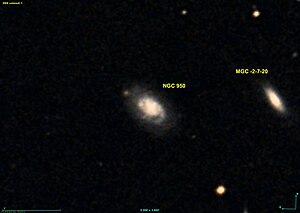NGC 950
| Galaxy NGC 950 |
|
|---|---|

|
|
| AladinLite | |
| Constellation | whale |
|
Position equinox : J2000.0 , epoch : J2000.0 |
|
| Right ascension | 02 h 29 m 11.8 s |
| declination | -11 ° 01 ′ 29 ″ |
| Appearance | |
| Morphological type | SB (rs) b: |
| Brightness (visual) | 13.8 mag |
| Brightness (B-band) | 14.6 mag |
| Angular expansion | 1.3 ′ × 0.8 ′ |
| Position angle | 40 ° |
| Surface brightness | 13.7 mag / arcmin² |
| Physical data | |
| Affiliation | LGG 63 |
| Redshift | 0.015651 ± 0.000100 |
| Radial velocity | 4692 ± 30 km / s |
|
Stroke distance v rad / H 0 |
(209 ± 15) x 10 6 ly (64.1 ± 4.5) Mpc |
| history | |
| discovery | Ormond Stone |
| Discovery date | 1886 |
| Catalog names | |
| NGC 950 • PGC 9461 • MCG -02-07-021 • IRAS F02267-1114 • 2MASX J02291177-1101287 • GALEX ASC J022911.70-110130.6 • LDCE 177 NED004 | |
NGC 950 is a spiral galaxy of Hubble type Sb in the constellation Cetus south of the ecliptic . It is an estimated 209 million light years away from the Milky Way and has a diameter of about 80,000 ly.
In the same area of the sky is the galaxy NGC 942 , NGC 943 , NGC 945 , IC 230 .
The object was discovered in 1886 by the American astronomer and mathematician Ormond Stone .
